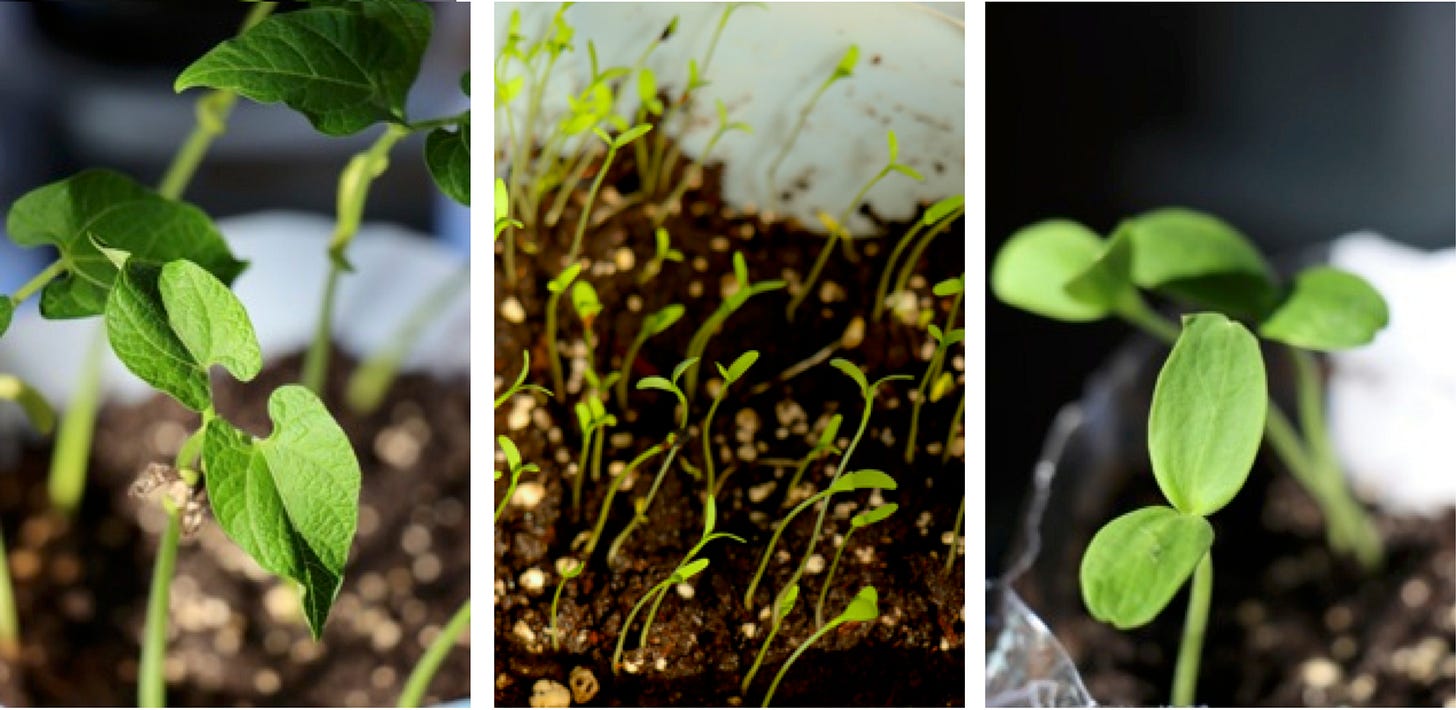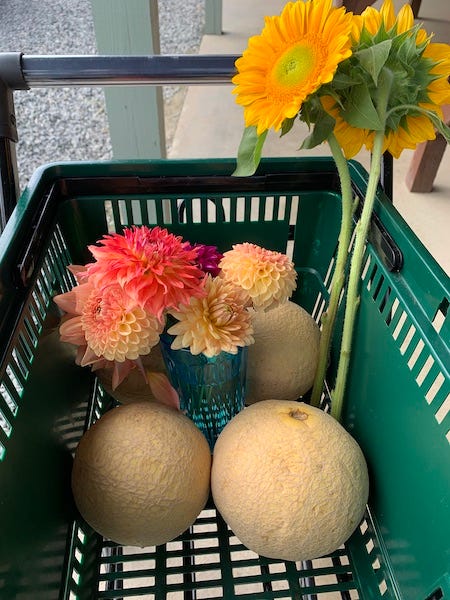. . . all of us rely, and must,
on our traditions and the deep
ancestral memories and ways
to bear us up and get us through
the deadly and uncertain days,
sustaining breath and sight and hope
on residue and legacy
of those beloved who came before
and watch us from the glittering stars.--Robert Morgan, from “Mound Builders” in Terroir (New York: Penguin Books, 2011)
It’s planting time, and as someone who writes about foods and native plants that quicken powerful sensory memories and help to shape our region’s identity and culture, I find myself especially grateful this spring. How welcome is the warming, the greening, the ritual of breaking ground, and the tradition of setting out seeds.
Signs of spring have finally come. The fig tree that first inspired this blog suffered through a severe but necessary pruning the winter before last and gave up a poor crop in August. Now, plump, pea-sized figs and tiny, unfurling leaves are like green lanterns at the tip of every limb. Though frost is still possible, I am buoyed.
For the first time in several years, instead of buying plants, we’ve launched a raft of seedlings on the dining room table in peat pots facing the Carrboro condo’s western windows. There’s probably way too much basil (is that really possible?), and next to that, a milk jug filled with starter soil for heirloom Masai beans (phaseolus vulgaris), that shot up and are already leaning toward the light.These bush beans, I’m told, are the gold standard in Europe, and can be grown in tall pots to discourage rabbits, if not squirrels. I’ll let you know. We’ll be planting all of these in the Blue Ridge Mountains for summer harvest.
We fetched up some North Georgia Candy Roaster squash seeds, first beloved and cultivated by the Eastern Band of the Cherokee for centuries, as described in a blog post a couple of years ago. I also mail-ordered an organic version of the Garden Peach tomato, described here in August. The Garden Peach, as its name suggests, is a yellowy-pinkish blushing fruit that is sweet and juicy.
I may be most excited, however, by the Sugar Cube seedlings--a hybrid cantaloupe that flourishes in western North Carolina, a variety that I tasted for the first time last summer.
Brevard was where we were headed--a town known for its outstanding summer music festival and its profusion of white squirrels, the descendants of a band of carnival specimens who escaped their handlers on the way through town long ago. Their pale progeny are still performing for visitors, and some will actually approach if you have a camera. Better have peanuts, too. I kid you not.
Our friends, Teri and Jimmy, who regularly escape the heat of Atlanta to take up residence for a few weeks on Slick Rock Mountain on See Off Road just outside Brevard, told us to be sure and stop on our way at the produce stand at McCall Farm, near the crossroads at Penrose, beyond Hendersonville. This family-run farm spreads across forty acres on a lush, highland plateau that is more or less framed by four rivers—the Mills, the Little, the Green, and the ancient French Broad. The latter, which flows north to Asheville and then curves northwest into Tennessee, has its headwaters in nearby Rosman and is already more than a trickle in this rolling landscape that’s frequently flooded.
Overall, Henderson County is perhaps best known for its scores of apple orchards around Edneyville to the north, made possible by thermal belts on the mountainsides that rise beyond the fertile bottomland, trapping a layer of warm air at night between the colder air in the bottoms and on the mountaintops above.
The southern section of the county that runs alongside the Green River is better known for its “gunpowder black” topsoil, which is dug up, bagged, and shipped all over the South, holding the root balls of nursery specimens. This far-flung distribution of the county’s most fundamental asset—dirt—is bemoaned in a poem by the county’s most distinguished native poet, Robert Morgan, whose Welsh ancestors settled in the village of Zirconia, where he grew up. Morgan, now celebrated in the North Carolina Literary Hall of Fame, lived a stone’s throw from Flat Rock, the town where the Illinois poet Carl Sandburg spent the last quarter of his life writing, while his wife raised prize-winning goats. Their progeny are still grazing on the Sandburg farm, now in the care of the National Park Service.
Of all these agricultural and literary treasures in Henderson County, I was not aware of its romance with the cantaloupe until we arrived at McCall Farm.
Two years before, while researching the July chapter for The Month of Their Ripening: North Carolina Heritage Foods Through the Year, we taste-tested the fragrant, homegrown Ridgeway and Rocky Hock cantaloupes. These two varieties of eastern NC melons are allowed to ripen in the field rather than being shipped out green like other cantaloupes from afar. However, the real secret of their sweetness, the fastidious growers claim, is the rocky soil in Ridgeway near the Virginia border and the salt and pepper sandy soil near Edenton. Both of these versions of eastern North Carolina terroir are said to magnify the sugar content. You may already know that the Ridgeway cantaloupe was so beloved in the 1930s that thousands of crates were shipped to cities in the north by train. The melon was a summer specialty at the restaurant in New York’s Waldorf Astoria Hotel. Only one commercial grower is left in the area.
Though today’s hybrid Sugar Cube is no heirloom, it is claimed to be “the most disease-free melon on the market,” according to Burpee Seeds. I got my seeds from Rare Seed House, a small family business in Manchester, Maryland, that eschews chemicals and pesticides. Sugar Cubes feature a very coarse skin--or netting as it is called--always a good sign when choosing a melon. They also pass the sniff test. You can smell these melons without picking them up--handy for the pandemic’s masked and no-touch shopping practices.
According to online sources, these little melons have a sugar content of 14 percent, which is considered high. Each melon weighs only two pounds or less and is a little larger than a softball. One melon can serve as a healthy dessert for two. A dollop of cottage cheese looks very appealing in the center, once the seeds have been scooped out.
We drove nearly two hours from the summer cabin in Little Switzerland three different times to buy them. What else did we have to do during the shutdown? We also loved McCall’s sweet corn, which locals stopped to buy by the bushel. They also offered giant blackberries, flavorful tomatoes, and dazzling dahlias, among other produce.
So, why—I can hear some of you asking—am I tempting you with the memory and flavor of chilled, sweet cantaloupe in April? Because it’s time to plant some for yourself, if you can, and I hope you’ll let me know how they grow for you. You can still find Sugar Cube melon seeds online. However, if you happen to be in Henderson County come July, you can also visit McCall Farm at 2400 Crab Creek Road, Penrose, NC, and buy a sample.
Longing for a taste is half its sweetness. Fragile, ephemeral, and seasonal—these are the qualities that define and quite literally ground us as humans. It dawned on me the other day that Nature’s withholding of special tastes except at certain times of the year is exactly what fast food vendors are trying to emulate when they create a false scarcity by bringing out certain processed foods for a limited time—Wendy’s codfish sandwich that my mother loved so much, the McRib which has no appeal to me whatsoever, and the bizarre ubiquity of pumpkin-spice-flavored everything from everybody around Halloween. No thanks.
As Robert Morgan put it in another poem in his Terroir collection, we cannot escape:
the simple addition and subtraction
of human time and sight, to which we cling
like pole beans to the lattice of the strings.1
From “Background Radiation” by Robert Morgan








